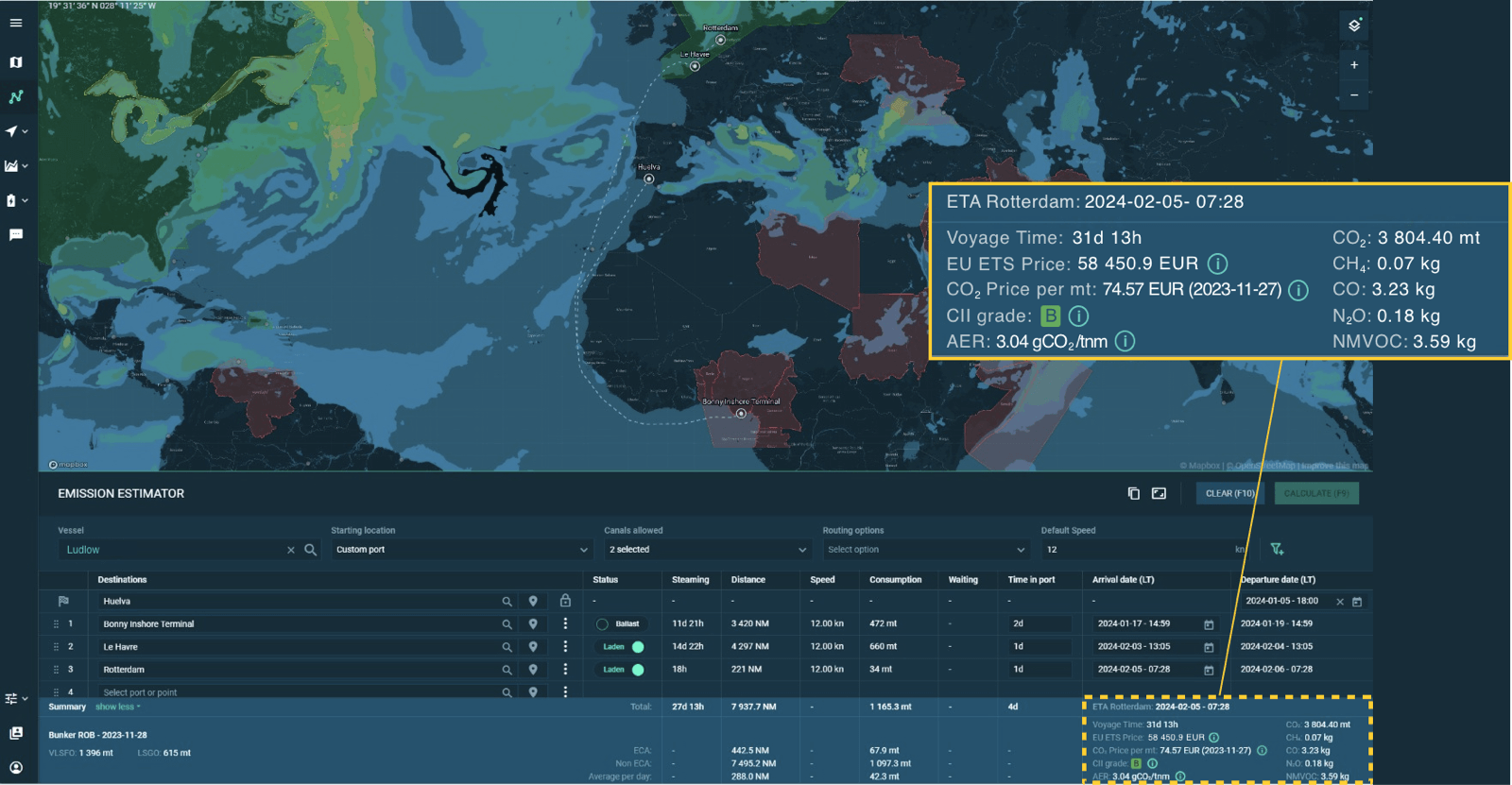
MCS' Emissions Estimator gives predictability on voyage costs with EU ETS on Orbit platform
Voyage costs are set to increase with the EU Emissions Trading System (EU ETS) that will demand clarity on emissions both to determine stakeholder liabilities and manage compliance. And Maritime Carbon Solutions (MCS) is providing emissions cost predictability for stakeholders using AI-generated data from nearly 15,000 voyages on the Orbit platform.
MCS, a joint venture between New York-based maritime software firm OrbitMI and broking giant IFCHOR GALBRAITHS, has developed the Emissions Estimator tool to deliver an accurate readout of estimated CO2 emissions on various routes, showing both EU ETS cost exposure and the impact on the IMO’s Carbon Intensity Indicator (CII).
“With thousands of voyages from all segments, the machine learning in the Orbit platform has already established a position as a reliable supplier of crucial accuracy for the industry,” says Kenneth Aasland, Director of Sustainability at IFCHOR GALBRAITHS.
“A lot of voyage data needed to be fed into the platform to provide reliable solutions,” he adds. Click here to read Streamlining Compliance with EU ETS through Orbit.
Emissions Estimator is a live solution that has already been running for several months to support shipping companies with reliable EU ETS cost calculations, with many voyages now under way set to become subject to the regulation once it kicks in.
Voyages in Orbit represent a wide range of clients, sectors and trades, including shipowners, pool operators, cargo owners, tankers, bulkers, time charters and spot voyages.
Both OrbitMI and MCS, a London-based information-as-a-service firm, rely on the Orbit platform’s powerful AI processing capability to deliver accurate emissions results for their respective clients in support of compliance with the CII and EU ETS, as well as the EU MRV, the IMO’s DCS and the AER.
And Aasland notes: “The platform effectively translates hundreds of pages of regulations into software, so clients don’t need to worry.”
The EU ETS, set to be phased in for shipping from 1 January 2024, will require shipowners to surrender EU Allowances (EUAs), or carbon credits, to cover their annual emissions - initially for 40% of emissions, rising to 70% in 2025 and 100% in 2026 - for voyages within and to/from the EU.
This is effectively a tax on the use of fossil fuels that will hike significantly costs for a voyage in line with the prevailing carbon price, with EUA costs to be allocated across the value chain in line with the ‘polluter pays’ principle based on stakeholders’ relative share of emissions.
Calculation of these costs is further complicated by the fact that voyages starting inside the EU to a discharge port outside the bloc, or vice versa, will be liable for 50% of emissions compared with 100% for those solely within the EU.
Gaining control and accurate oversight of emissions cost exposure ahead of time will therefore be a crucial part of voyage planning and an important competitive factor for shipowners in securing charters.
With Emissions Estimator, the end-user creates a voyage route by inputting origin and destination ports, as well as reasonable expectations for time in canals and activities at ports along the way. The system then returns a visualization of the route, its length in nautical miles, overall duration and estimates for bunker consumption, overall CO2 emissions, the voyage’s impact on CII and its EU ETS exposure. The impact of weather on the route is also taken into account.
This exposure is expressed in US dollars but is available in any currency, based on the daily end-of-day price as set by leading carbon service provider ClearBlue Markets that feeds price data into the Orbit platform.
The platform automatically calculates an estimate for total EU ETS costs, based on the current carbon price, in accordance with varying liabilities during the three-year roll-out period.
Taking the example of an international voyage, the Suezmax oil tanker Ludlow (a real vessel of which the name has been changed for confidentiality reasons) is sailing from Spain to the Bonny Inshore Terminal in Nigeria, and returning to Europe. The vessel is open (ballasting) from Huelva, loads at Bonny, then discharges at Le Havre and Rotterdam.
Once this itinerary is inputted into Emissions Estimator, pressing ‘calculate’ will generate a route with estimates for steaming time, distance, speed and fuel consumption. The platform then automatically estimates the AER and CII ratings for the voyage.
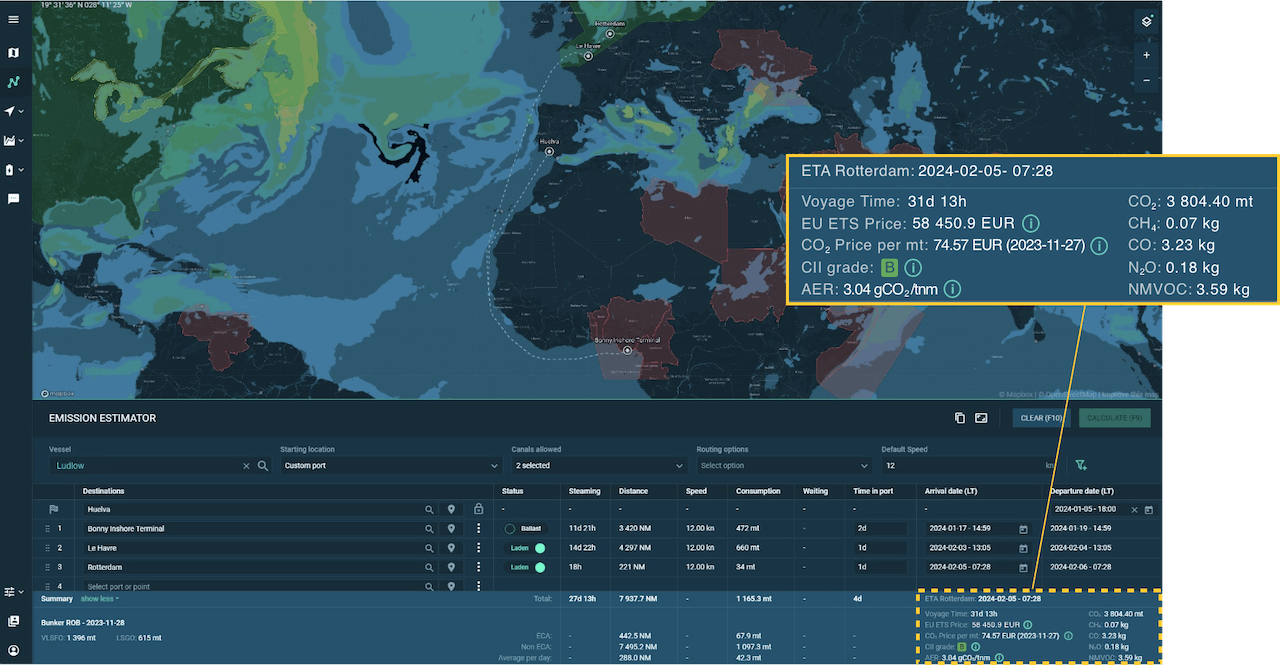
In this case, the total EU ETS cost would be €58,450.90, based on estimated CO2 emissions and an EUA spot price of €74.57, for a voyage taking place in 2024. Users can toggle between different years to see the associated costs.
These costs must be calculated on a per leg (or ‘section’) basis, given there is differentiated liability for voyages inside and outside the EU under the regulation.
Visualizations show the leg from Huelva (inside EU) to Bonny (outside EU) carries a cost of 50% of emissions, as does the leg from Bonny back to Le Havre (inside EU). This calculation is indicated by ‘0.5’ in the chart. The leg from Le Havre to Rotterdam carries a cost of 100% of emissions and is indicated by the ‘1’ in the chart.
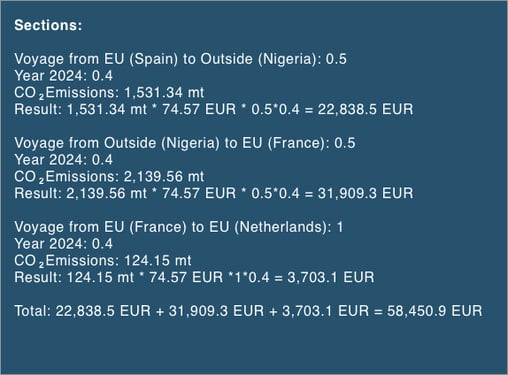
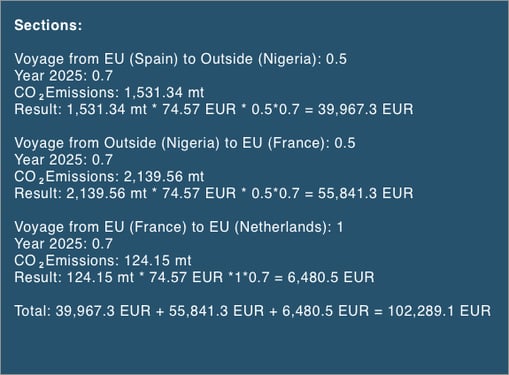
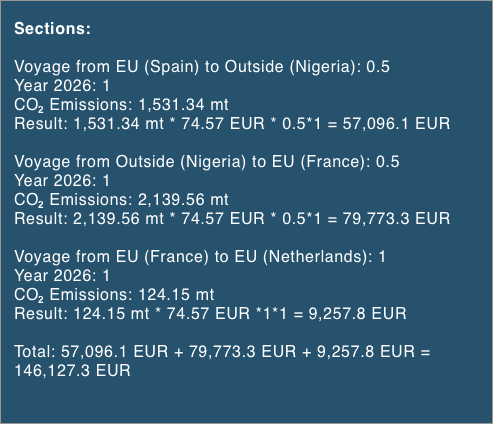
OrbitMI CEO Ali Riaz explains: “At the heart of the tool is a micro-service for calculating CO2 emissions from vessels. This service reflects the latest guidance in multiple regulations, such as EU ETS, CII and AER, as well as the recently adopted FuelEU Maritime. As regulations change, we change the micro-service. Consequently, both Orbit and MCS run on our future-proof platform.”
Adaptability to complex and changing regulations was a key factor behind Bureau Veritas’ (BV) recent strategic collaboration with OrbitMI to accelerate development of data-driven solutions for shipping, according to BV Marine & Offshore’s Vice President, Digital Solutions & Transformation, Laurent Hentges.
“In practice, addressing the requirements of the EU ETS requires both completeness and sophistication combined with years of data for machine learning,” Hentges says. “Among the many reasons for our investment in OrbitMI was the platform’s abilities in translating the parameters of the regulation into an easy-to-use estimation solution.”
We can help you with your EU ETS strategy
Contact us below to schedule a conversation
OrbitMI Inc. is a NYC-based software-as-a-service company with offices and partners across the world. Our customers use our solutions to operate their fleets more profitably, efficiently, safely and sustainably by connecting multiple systems into intelligent connected workflows directly via desktop and mobile app. OrbitMI was named a ‘Leader’ by Thetius IQ in its Market Landscape Report - Voyage Optimisation Solutions 2023.
Maritime Carbon Solutions, an information-as-a-service firm that provides shipowners and cargo owners with precise and real-time information on CO2 emissions, is a joint venture between OrbitMI and IFCHOR GALBRAITHS.
These Stories on Featured